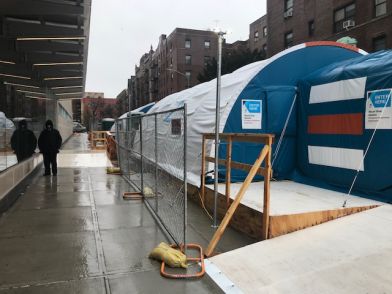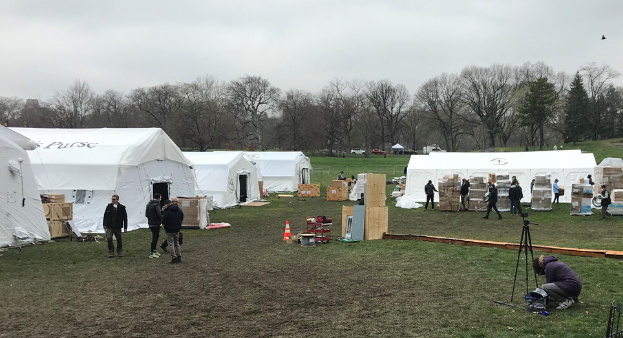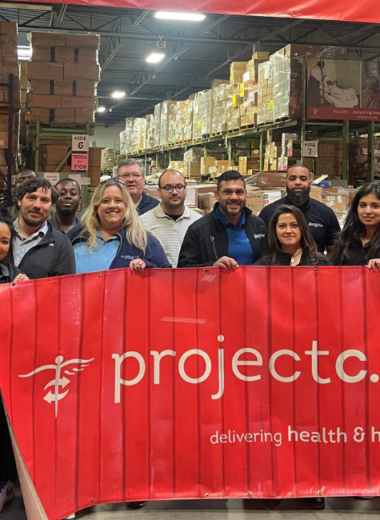With hospitalizations of new patients in New York finally starting level off in mid-April, the epicenter of the COVID-19 could move to other areas of the country soon. If that happens, here are some of the best practices we've employed to save lives and help stop the spread of the disease:
By Chris Hariegel, Crothall Healthcare Facilities Management, Vice President, Operations – Engineering
Since New York became the COVID-19 epicenter in late March, our work there at Mount Sinai Hospital has been non-stop. The Crothall Facilities Management team has been an integral part of the hospital’s mission to save lives by building new facilities to care for these patients, both within the hospital and in New York’s Central Park.
I’ve worked in Facilities Management for 20 years at Crothall and closely with all hospitals in the Mount Sinai Health System since 2013. Fortunately, we continuously work with the hospital and government agencies on emergency planning drills that even include how we will respond in case of a military strike by a foreign country, so we’ve been able to anticipate nearly every situation during this crisis.
With hospitalizations of new patients in New York finally starting level off in mid-April, the epicenter of the COVID-19 could move to other areas of the country soon. If that happens, here are some of the best practices we’ve employed to save lives and help stop the spread of the disease:
Converted Regular Patient Rooms to Airborne Isolated Rooms

If your facility begins to reach patient capacity, be sure to explore other spaces that can be converted for COVID-patient care. With stringent restrictions on guest entry, some hospitals have transformed lobbies into airborne isolate rooms. These adjustments also benefit hospital staff who feel more secure once these adjustments are made.
Split Management Teams
Within a few days, it became clear the disease would be with us for several weeks. With approximately 2,000 COVID-19 patients under care at Mount Sinai, we needed to minimize our management teams’ exposure to the disease. No organization can afford to lose an entire management team during this fight.
To accomplish that goal, we split our management into Team A & Team B, giving us two “stand-alone” teams to run Facilities Management. While one group is working their shift at the hospital, the second team group can work remotely to handle all other responsibilities. This approach prevents a whole team from being exposed to the disease while also ensuring 24/7 support.
Lean on Relationships with Government Agencies to Pull Off Special Projects
Even after converting hundreds of patient room, it soon became clear more rooms were needed. Approximately two weeks ago, The Samaritan’s Purse Emergency Field Hospital in Central Park opened with 14 tents and a 68-bed respiratory care unit.
We helped acquire the tents, secure the building permits, and construct the air conditioning system for the AII units in these tents. We also secured and built a liquid oxygen farm and installed the plumbing, water, and emergency power where needed.
Getting this unique site up and running was possible due to strong working relationships and regular communication with people in companies and government agencies. For the Central Park tents, we worked with Consolidated Edison to provide temporary power to a location where this service did not exist. We worked closely with the city’s Office of Emergency Management and several other agencies to gain permits. We worked closely with the New York City Fire Department (FDNY) to inspect all locations as they were installed to ensure they were informed of all temporary locations and services.
If you need help with a similar project in your city or state, reach out to us to learn how we helped hospitals in New York.
Oxygen Supply
Treatment of COVID-19 patients places a significant demand on the facility’s oxygen supply systems. The current treatment process has heavily taxed our bulk and cylinder supplies. Wear and tear are beginning to show on parts of our system because of additional usage; many systems are reaching their limits. Ensuring your systems are in the best operating condition is crucial to getting through this crisis. Reach out to your vendors and supplier to make sure you are prepared.
Postpone All Non-Critical Projects
It may seem obvious but work closely with your hospital and any local government officials to postpone any non-critical construction projects during the crisis. In our case, project managers working on other building construction projects at the hospital were redeployed to the FM team, providing us with additional resources to support a 24/7 operation. Rather than furlough these employees, they can be used for overnight and weekend projects that otherwise would need people from the regular FM team.
We’re here to help. Check out our COVID-19 Resources!
Related Posts
Let’s Talk About the Right Solution for Your Organization
Get in touch to discuss how Crothall Healthcare’s services and solutions can help your healthcare organization exceed its goals. You’ll learn more about:
- The transparency we bring to outsourced support services
- How we design customized solutions for your unique needs
- The technology and innovation Crothall delivers across all our services



